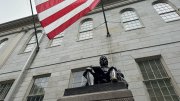An interesting perspective on faculty growth, a core element of Harvard’s mission, emerges from the intersection of Harvard Campaign plans and constrained research funding. In their annual-report letter, CFO Thomas J. Hollister and treasurer Paul J. Finnegan cited academic investments, including “expanded faculty.” The capital campaign aims at many objectives (financial aid, House renewal, the new engineering and applied sciences facility), but most schools do not identify faculty growth as a major goal. President Drew Faust noted that the campaign had secured endowments for 75 chairs, but most are understood to be existing professorships.
The problem is sufficiently acute that Faculty of Arts and Sciences (FAS) dean Michael D. Smith, sharing his annual report with colleagues in early October, emphasized research funding as among his highest priorities. The report’s financial commentary singled out the importance of “enhanc[ing] our internal program of research support to lessen faculty anxiety in an increasingly competitive market and challenging external funding landscape”—so much so that FAS expects to maintain its tenured- and tenure-track-faculty ranks at roughly the current 729 members, rather than seeking to add professorships, with implications for its composition.
From academic year 2000-2001, when these “ladder” faculty numbered just below 600, to the current population, FAS’s profile has shifted. Arts and humanities professors rose from 185 to a peak of 210, and now number 196; the ranks of social scientists increased from 214 to a peak of 251, before settling at 245 now. The science cohort, at a multiyear low of 139 in 2000-2001, peaked at 214 and now numbers 203—up by nearly half. And engineering and applied sciences, with 54 faculty members 15 years ago, before becoming a full school, has been on a steep upward trajectory, to 85 now: up nearly 60 percent. With the faculty census essentially level and engineering-related fields targeted for significant expansion (funds are in hand to add a dozen computer-sciences professors alone), FAS’s mix of disciplines might continue to evolve.








